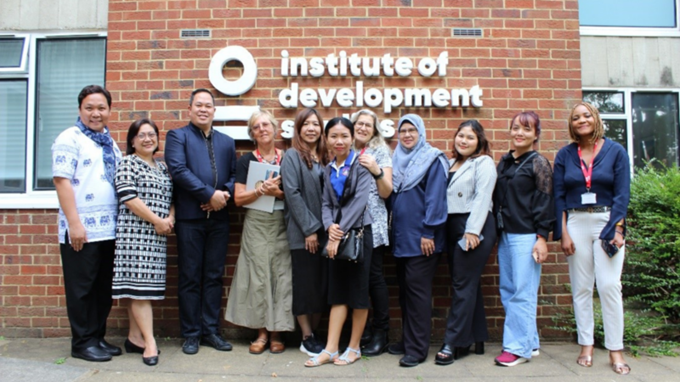Highlights from university leaders’ IDS immersive workshop
Cập nhật lúc 14:55, Thứ năm, 10/08/2023 (GMT+7)
During the last week of June, we played host to several prominent university leaders and academics from across Southeast Asia. Funded by the British Council and Southeast Asian Ministers of Education Organization Regional Centre Specialising in Higher Education and Development (SEAMEO RIHED), this high-level workshop at IDS examined issues of gender equity, diversity and inclusivity (GEDI) within higher education.
    |
 |
| Group of Southeast Asia university leaders standing with IDS Colleagues. Photo by James Andrews, IDS |
Higher education institutes’ (HEI) policies and practices need to be reflective of emerging gender and development issues including those of racial inequalities, disability studies and the intersecting inequalities that lock people out of positions of leadership in these institutions.
The aim of the workshop that we hosted was to expose partners to the diverse body of work around gender, equity, diversity and inclusivity going on at Sussex University and IDS. We aimed to engage partners in reflection and analysis of their own respective scenarios providing a common space for sharing futuristic leadership tools to promote gender equity, diversity and inclusivity and to build sustainable relationships and networks for potential future collaboration. The workshop, along with other UK and Southeast Asia events, will feed into a white paper on the topic of transformation management in higher education for policy actors in the region.
During the immersive workshop, many partners shared with us the challenges and opportunities for integrating GEDI issues into their respective higher education institutions. Key outcomes from the our workshops included the following discussed and agreed highlights.
Here are 10 highlights from the workshop:
- HEI leaders should be driven by values and should recognise people’s private lives – acknowledging that staff have children, have to pick them up or bring them to work sometimes etc. Thus, the need for the recognition of, and to make provisions for people that have caring responsibilities (childcare, sick care, care of aging parents, for example). This leads into implementation of policies that offer flexibility that allow inclusive participation in the works place.
- Senior higher education leaders should find ways to recruit, employ and promote women at senior levels, and be determined and dogged in pursuit of this. It is important to recognise that there are barriers, some of which are hidden and therefore to keep trying to change the general mindset about new approaches – year after year (if it doesn’t work one year, try again the next year).
- Higher education curriculums should include gender teaching at different levels. This creates a body of skilled professionals and active students, who are at the cutting edge of research and teaching pedagogy on gender and intersectionality, and aware of other marginalisations. However, it is also important that higher education institutes do not make these staff the only representations of gender work and thereby overwork and exploit these professionals.
- Gender is more than just including women academics or counting the numbers of women participating. Do not just ‘add gender and stir’. Leaders should be deliberate in promoting research into gender across the academic disciplines that goes beyond tokenism.
- As HEI leaders working at the cutting edge of Gender, Equity, Diversity and Inclusion, it is crucial to develop a network of support within and/or beyond the university and national institutions. Working with like-minded individuals who are also trying to bring about change offers support and inspiration.
- Work to try and change policy – at higher education and national level – to always address gender and other marginalisations. Neutral policy is not gender EDI policy, and, where necessary and/or possible, do more than policy dictates when necessary (e.g. equal pay if not specified).
- Have a policy framework for understanding what kinds of interventions are desirable (what kind of mix of activities are needed) across higher education institutes that provide legislative support for the institutionalisation of gender EDI. This can include assessing the kinds of exclusions experienced by a particular higher education institute, monitoring gender ratios, reviewing gender EDI initiatives across the university, understanding what research is being conducted, being aware of power relations and other barriers to inclusion.
- Measure progress annually against the policy framework (check what is working and ask what is not, and why) and adjust strategic direction as necessary.
- Don’t be complacent, even if gender statistics look good on paper, explore underlying power dynamics.
- Be aspirational, there is always more to be done: other marginalised groups to bring into higher education and ways to enhance gender EDI in higher education, and through this to address inequalities locally, nationally and globally.
During the workshop, we shared some of the many challenges and opportunities that it had experienced in its gender equity, diversity and inclusion work; including around researching and teaching on gender; about our recruitment practices and enhancing equality and inclusion; sharing our initiatives to improving accessibility for people with disabilities. Much of what was shared resonated with workshop participants’ own concerns about integrating GEDI issues into their respective HEIs. For IDS Consultants, Linda Waldman, Violet Barasa and Juliet Millican, the rich and varied exchanges and learnings that took place during the workshop are very significant.
The ability to host a face-to-face meeting with Southeast Asian partners was particularly important and was a fitting culmination of many months of online workshops and interactions. Face-to-face interactions are also important because, implementing the highlights mentioned above and undertaking gender equity, diversity and inclusion in higher education institutes, is seldom straightforward and leaders can encounter many challenges along the way. Face-to-face interactions provide the opportunity for the building of trust, creating networks and generating the support of allies, within universities, within countries and internationally.